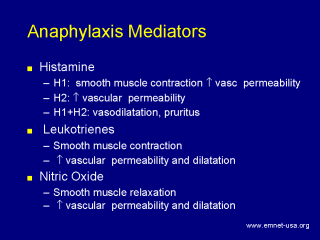 |
Mediators from mast cells
and basophils account for most of the signs and symptoms of anaphylaxis.
Histamine is a bronchoconstrictor and causes vasodilatation and increased
vascular permeability. The cardiovascular effects of histamine occur through
action on both H1 and H2 receptors. Numerous studies have demonstrated that
the hypotensive effect of histamine infusion can only be blocked by the use
of an H1 antihistamine combined with the H2 antihistamine cimetidine.
It is unknown whether other H2 antihistamines would also be effective since
these have not been studied. Increased serum histamine and tryptase levels
have been demonstrated in patients with anaphylaxis. Leukotrienes are also
likely to contribute to the anaphylactic syndrome. They cause
bronchconstriction and increased vascular dilatation and permeability.
Finally, it is likely that increased nitric oxide production occurs in human
anaphylaxis, as has been demonstrated in animals. Nitric oxide is a potent
vasodilator. L-arginine is converted to nitric oxide as histamine binds to
H1-receptors during phospholipase-C-dependent calcium mobilization. Tumor
necrosis factor released from mast cells also induces nitric oxide
production. Nitric oxide production may be responsible for
vasopressor-resistant cases of anaphylactic hypotension. |
